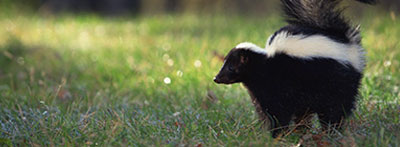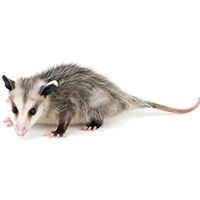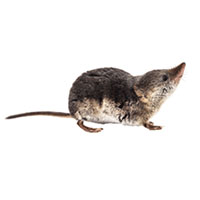Skunk Diet
Skunks feed on small mammals, eggs, fruit, berries, insects, food scraps in the trash, dog feces, farm poultry, and eggs.
Skunk Habitat
Skunk habitats vary from pastures to open lands bordering forests. They will also live under decks, under sheds, or in burrows, hollow logs, or wood or rock piles. Skunks do not hibernate but generally remain inactive during winter, surviving on their fat stores and only leaving their den for short periods during warm weather.

Skunk Life Cycle
One male may breed with several females during February and March. After mating, female skunks move to a maternal den using grass for bedding. Generally, four to seven young are born about nine weeks after mating in May or June. The young are blind and deaf at birth with short, fine fur. The young are nursed in the den for about six weeks before joining their mother on trips outside the den. By this time, they are miniature replicas of adults. The young are weaned by about two months of age.
Skunk Damage
Spray People and Pets
When feeling threatened, a skunk will spray people or pets with an oily liquid containing sulfur compounds that are produced by two glands at the base of the tail. Skunks are capable of spraying accurately up to 20 feet. The spray can be painful and blind pets and people temporarily.
Carry Rabies
Skunks are also a serious public health threat. In the U.S., they are second to the raccoon in the number of reported rabies cases among wildlife animals.
Inhabit Structures
Skunks will often dig along the edges of structures and take up residency beneath foundations, porches, decks, and sheds.
Damage Lawns
Skunks are known to tear up lawns and landscaping as they dig for insect larvae.
Raid Gardens
Unfenced gardens are commonly raided by skunks for fruits and vegetables.
Damage Beehives
Skunks will feed on both adult and larval bees.
Skunk Prevention & Control
Skunk Prevention
Like many pests, the most effective way to make your property less attractive to skunks is to reduce access to the food, water, and shelter that the animals need. Minimize sources of these close to your property by:
- Removing brush piles, weed patches, stone piles, and other debris.
- Fallen fruit and spilled seed from bird feeders should be removed frequently.
- Garbage cans should have tight-fitting lids.
- Food placed outdoors for pets should be removed by nightfall.
- Close off all potential entrances or openings under houses and decks, garden tool sheds, mobile homes, porches, and decks with 1/4″ mesh hardware cloth. The advantage of using the small mesh is that it will also exclude rats and house mice if installed correctly. Skunks will work hard to get into a desirable den space, so take care to make fittings good and tight. If there is soil underneath the potential entrances, bury the wire at least six inches to discourage skunks from digging under.
Skunk Control
Much of wildlife control is knowing and understanding the habitat and behavior of the animal. For skunks, Batzner uses live trapping and/or covered trapping baited with cat food, chicken entrails, or sardines with brussel sprouts, carrots, or lettuce.
If you’re having problems with skunks around your home or business, contact a pest control professional for expert removal services.
Need help with Skunks?
We'll call you! Leave your information below.





